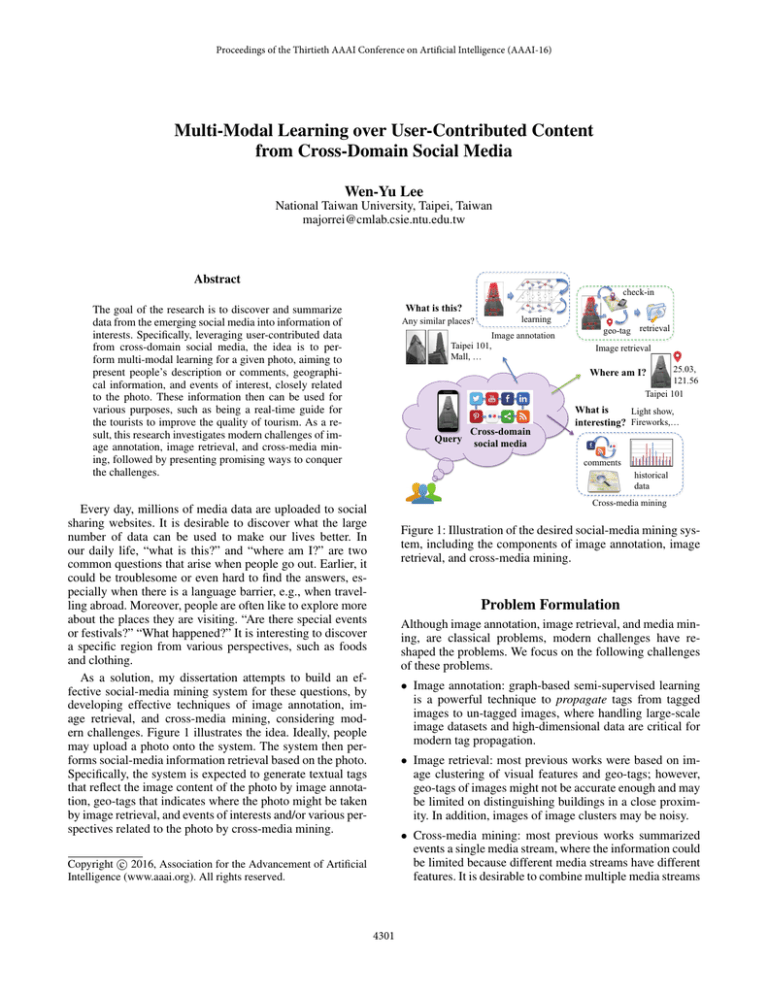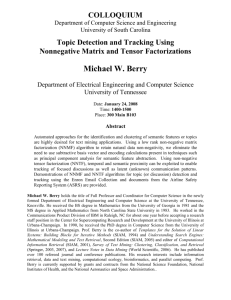
Proceedings of the Thirtieth AAAI Conference on Artificial Intelligence (AAAI-16)
Multi-Modal Learning over User-Contributed Content
from Cross-Domain Social Media
Wen-Yu Lee
National Taiwan University, Taipei, Taiwan
majorrei@cmlab.csie.ntu.edu.tw
Abstract
check-in
What is this?
The goal of the research is to discover and summarize
data from the emerging social media into information of
interests. Specifically, leveraging user-contributed data
from cross-domain social media, the idea is to perform multi-modal learning for a given photo, aiming to
present people’s description or comments, geographical information, and events of interest, closely related
to the photo. These information then can be used for
various purposes, such as being a real-time guide for
the tourists to improve the quality of tourism. As a result, this research investigates modern challenges of image annotation, image retrieval, and cross-media mining, followed by presenting promising ways to conquer
the challenges.
Any similar places?
learning
Image annotation
Taipei 101,
0DOO«
geo-tag retrieval
Image retrieval
Where am I?
25.03,
121.56
Taipei 101
What is
Light show,
interesting? )LUHZRUNV«
Query
Cross-domain
social media
comments
historical
data
Cross-media mining
Every day, millions of media data are uploaded to social
sharing websites. It is desirable to discover what the large
number of data can be used to make our lives better. In
our daily life, “what is this?” and “where am I?” are two
common questions that arise when people go out. Earlier, it
could be troublesome or even hard to find the answers, especially when there is a language barrier, e.g., when travelling abroad. Moreover, people are often like to explore more
about the places they are visiting. “Are there special events
or festivals?” “What happened?” It is interesting to discover
a specific region from various perspectives, such as foods
and clothing.
As a solution, my dissertation attempts to build an effective social-media mining system for these questions, by
developing effective techniques of image annotation, image retrieval, and cross-media mining, considering modern challenges. Figure 1 illustrates the idea. Ideally, people
may upload a photo onto the system. The system then performs social-media information retrieval based on the photo.
Specifically, the system is expected to generate textual tags
that reflect the image content of the photo by image annotation, geo-tags that indicates where the photo might be taken
by image retrieval, and events of interests and/or various perspectives related to the photo by cross-media mining.
Figure 1: Illustration of the desired social-media mining system, including the components of image annotation, image
retrieval, and cross-media mining.
Problem Formulation
Although image annotation, image retrieval, and media mining, are classical problems, modern challenges have reshaped the problems. We focus on the following challenges
of these problems.
• Image annotation: graph-based semi-supervised learning
is a powerful technique to propagate tags from tagged
images to un-tagged images, where handling large-scale
image datasets and high-dimensional data are critical for
modern tag propagation.
• Image retrieval: most previous works were based on image clustering of visual features and geo-tags; however,
geo-tags of images might not be accurate enough and may
be limited on distinguishing buildings in a close proximity. In addition, images of image clusters may be noisy.
• Cross-media mining: most previous works summarized
events a single media stream, where the information could
be limited because different media streams have different
features. It is desirable to combine multiple media streams
c 2016, Association for the Advancement of Artificial
Copyright Intelligence (www.aaai.org). All rights reserved.
4301
for high performance and different perspectives.
date, the regrouping approach will be implemented and evaluated based on two or more image datasets.
Multi-tag propagation on large-scale datasets
Cross-media mining for events of interest
Extended a prior work on single-tag propagation (Zhou
et al. 2004), I developed a scalable multi-tag propagation
approach using the MapReduce programming model, so
as to confront large-scale datasets with high-dimensional
data (Lee et al. 2013). Further, unlike traditional ad-hoc approaches, I determined the number of iterations for iterative
learning by formulating an all-pair shortest path problem for
a better performance. Finally, I extended the weight learning technique (Jiang, Wang, and Chang 2011) for the refinement of tag assignment, considering multiple similarity
graphs of images. An experiments was conducted on a largescale image dataset that contains more than 540,000 images
with 9,360 annotated ground truth images in 21 query categories. Results showed that my approach improved about
77% mean average precision for top-10 tags, compared with
a common approach considering only visual features.
Further, we discovered relevance of tags and images (Wu
et al. 2013).1 Future work includes the improvement of the
approach and then uses the approach to identify noisy tags
generated during the learning process for adaptive learning
on tag propagation.
Previous works, such as (Sakaki, Okazaki, and Matsuo
2010), mostly focused on mining events of interest from
a single media stream. Intuitively, unifying multi media
streams is capable of achieving better performance than considering one stream alone, because every media stream has
unique information and features. As a case study, I conducted an experiment in our preliminary work (Kuo et al.
2014)3 that compared top-100 popular places from different
media streams, including Twitter, Instagram, TripAdvisor,
and one NYC open data. As expected, each media stream
has its own unique information and features, and it is desirable to do cross-domain combination.
In addition, I led a team to investigate what people may
concern with for different types of events, by extracting latent sub-events with diverse and representative attributes for
pre-selected events (Lee et al. 2015).4 Currently, I am working on unifying information of social websites and that of
taxi datasets to detect events of interest in a city. By the
workshop date, I will evaluate the performance of my current approach and refine the approach accordingly.
References
City-view image retrieval using check-in data
Jiang, Y.-G.; Wang, J.; and Chang, S.-F. 2011. Lost in binarization: query-adaptive ranking for similar image search with compact
codes. In ACM ICMR.
Kuo, Y.-H.; Lee, W.-Y.; Hsu, W.; and Cheng, W.-H. 2011. Augmenting mobile city-view image retrieval with context-rich usercontributed photos. In ACM MM, 687–690.
Kuo, Y.-H.; Chen, Y.-Y.; Chen, B.-C.; Lee, W.-Y.; Wu, C.-C.; Lin,
C.-H.; Hou, Y.-L.; Cheng, W.-F.; Tsai, Y.-C.; Hung, C.-Y.; Hsieh,
L.-C.; and Hsu, W. 2014. Discovering the city by mining diverse
and multimodal data streams. In ACM MM, 201–204.
Lee, W.-Y.; Hsieh, L.-C.; Wu, G.-L.; and Hsu, W. 2013. Graphbased semi-supervised learning with multi-modality propagation
for large-scale image datasets. Elsevier JVCIR 24(3):295–302.
Lee, W.-Y.; Kuo, Y.-H.; Hsieh, P.-J.; Cheng, W.-F.; Chao, T.-H.;
Hsieh, H.-L.; Tsai, C.-E.; Chang, H.-C.; Lan, J.-S.; and Hsu, W.
2015. Unsupervised latent aspect discovery for diverse event summarization. In ACM MM, 197–200.
Lee, W.-Y.; Kuo, Y.-H.; and Hsu, W. 2013. City-view image retrieval leveraging check-in data. In ACM GeoMM, 13–18.
Sakaki, T.; Okazaki, M.; and Matsuo, Y. 2010. Earthquake shakes
Twitter users: real-time event detection by social sensors. In ACM
WWW, 321–328.
Wu, C.-C.; Chu, K.-Y.; Kuo, Y.-H.; Chen, Y.-Y.; Lee, W.-Y.; and
Hsu, W. 2013. Search-based relevance association with auxiliary
contextual cues. In ACM MM, 393–396.
Zhou, D.; Bousquet, Q.; Lal, T. N.; Weston, J.; and Schölkopf, B.
2004. Learning with local and global consistency. In NIPS, 321–
328.
Our preliminary study presented a real-time retrieval system
leveraging visual features and geo-tags (Kuo et al. 2011).2
To remedy the deficiency of geo-tags, to the best of our
knowledge, I further presented the first work that unifies visual features, geo-tags, and check-in data of images for cityview image retrieval (Lee, Kuo, and Hsu 2013). Check-in
data were regarded as complementary location information
of images, in contrast to geo-tags. For data pre-processing,
check-in data were used for initial image clustering. Sparse
coding with effective dictionary selection was then used to
discover critical feature dimensions of images for each cluster. For image retrieval, a ranked list of images will be generated based on a given photo. The check-in location and
geo-tags of clusters can be used to indicate where the given
photo may be taken. Experiments on an image dataset of
San Francisco showed that the approach outperformed common approaches that considers visual features only, geo-tags
only, and both of visual features and geo-tags.
Recently, I observed that some check-in data may be
noisy. Some photos might not be closely related to the places
these photos were taken at, but related to other places. For
example, image contents of photos taken at a skyscraper
may be more closely related to buildings near the skyscraper
than the skyscraper itself. As a result, I have developed a
location-aware regrouping approach to optimize initial clusters for search performance improvement. By the workshop
1
This work received the first place of ACM Multimedia 2013
MSR-Bing Image Retrieval Challenge (Industrial Track), and the
ACM Multimedia 2013 Grand Challenge Multimodal Award.
2
This work was accepted as the finalists for ACM Multimedia
2011 Grand Challenge.
3
This work received the ACM Multimedia 2014 Grand Challenge Multimodal Award.
4
This work was accepted as the finalists for ACM Multimedia
2015 Grand Challenge.
4302





